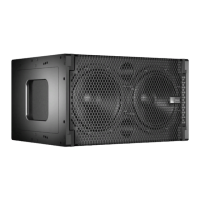M1D Rigging Grids and Accessories
PN: 05.115.001.01 B
Page 14 of 24
Meyer Sound Laboratories Inc.
www.meyersound.com
T: +1 510 486.1166
F: +1 510 486.8356
M1D Rigging Grids and Accessories
PN: 05.115.001.01 B
Page 15 of 24
Meyer Sound Laboratories Inc.
www.meyersound.com
T: +1 510 486.1166
F: +1 510 486.8356
USING THE MG-1D GRID TO TRANSITION FROM M2D TO A SINGLE UPA-1P LOUDSPEAKER
When transitioning from an M2D array, this conguration provides 0° to 7° of down tilt in 1° increments for a downll
comprised of a single UPA-1P compact wide coverage loudspeaker. The UPA-1P provides a total of 100° of horizontal
coverage. The UPA-1P can also be own independently with the MG-1D grid from a single pick-up point on the
frame’s center bracket.
To assemble this conguration, lift the D-Rings on the UPA-1P and guide them into each hole marked with a triangle
on the MG-1D grid. Fasten by fully inserting the quick release pins (QRPs) into the appropriate holes in the grid while
securing the D-Rings. The MG-1D grid can then be attached to the M2D system using the M2D CamLinks, M2D front
links and M2D 5/16” QRPs.
Maximum Load:
Triangle-marked UPA pick-up points.
7:1 safety factor: 2 rows of (1) UPA-1Ps
154 lbs (70 kg)
CAUTION: When using the
MG-1D grid as a top grid
to y a UPA-1P, it must always be
supported by at least one pick-up
hole from the main frame’s center
bracket. The extension frame may
be used as a secondary pick-up
location for tilting the array or
spreading the load between two
points.
CAUTION: When ying an
MG-1D grid and a UPA-1P
beneath an M2D array, include
the weight of the grid and the
weight of the UPA-1P in your total
weight calculations. Do not exceed
the weight rating of the primary
supporting grid.
WARNING: The leveling feet must always be detached from the MG-1D grid before ying a system.
Unscrew the entire assembly, including the threaded leg, and remove completely.

